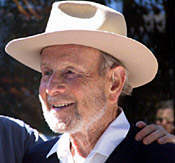|

|
|
By his own account, Dr. Wayburn was neither a "joiner" nor an "organization man," but he saw the Sierra Club as both a way to explore his beloved Sierra Nevada and as the most effective way to salvage the wild character of an America he saw vanishing before his eyes. While the Bay Area was his focus, the five-time Sierra Club president also strove to preserve wilderness nationwide. A San Francisco Chronicle profile marking his centennial birthday in 2006 credited him with saving 100 million acres of mountains, meadows and rivers in California and Alaska--a million acres per year of his life. In the early 1970's he fought to create the Golden Gate National Recreation Area (GGNRA). In his memoir, Your Land and Mine, Wayburn recounted meeting with Representative Phillip Burton. Wayburn was seeking his help in creating the Golden Gate National Recreation Area.
[Burton] studied my maps ... then asked, "Is this what you want?"
According the 2006 Chronicle article: The two were quite a contrast: big, brash Burton and slim, soft-spoken Wayburn, then a Republican. "I offered to change the registration of my party. Phil said, 'Oh, no. I need you to introduce as my Republican constituent on the Capitol steps.' Later, I did change my registration, but not until after Phil died," Wayburn remembered. When the National Park Service opposed Dr. Wayburn's plan for the Golden Gate National Recreation Area, favoring the establishment of a much smaller park instead, Nixon's Secretary of the Interior, Rogers Morton was called upon to testify before the Senate Interior Committee. No great fan of environmentalists, Morton surprised everyone by supporting the Sierra Club's proposal in full. Morton told the shocked hearing: "The Park Service wants me to support their plan, but I went out there to the site with my friend Dr. Wayburn, and he convinced me otherwise."
One, daughter Cynthia Wayburn said. "He has hiked, walked or run almost every day of his life," she says. "Throughout his life he has exercised his mind equally, working as a physician through his 83rd year and as a conservationist up through 99 years of age--two simultaneous jobs for over 40 years."
In 1999, when he received the National Medal of Freedom, he whispered something in President Clinton's ear. Back at Sierra Club Headquarters where he still had an office, they asked him what he said. "Sequoia is next" is what he replied. In his 2004 book, "Your Land and Mine: Evolution of a Conservationist," he explained why he spent so much of his life on environmental causes: "Whenever we encroach on the natural world, we crop the boundaries of our own existence as humans, cut off our fields of solace and sensation. Vistas, textures, odors and sound fade and then disappear. In destroying wildness, we deny ourselves the full extent of what it means to be alive.''
Books:
Links: Return to People
| |